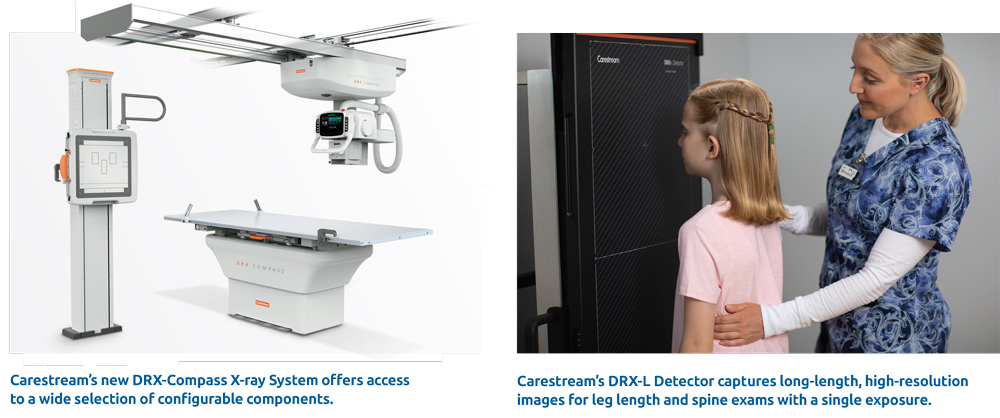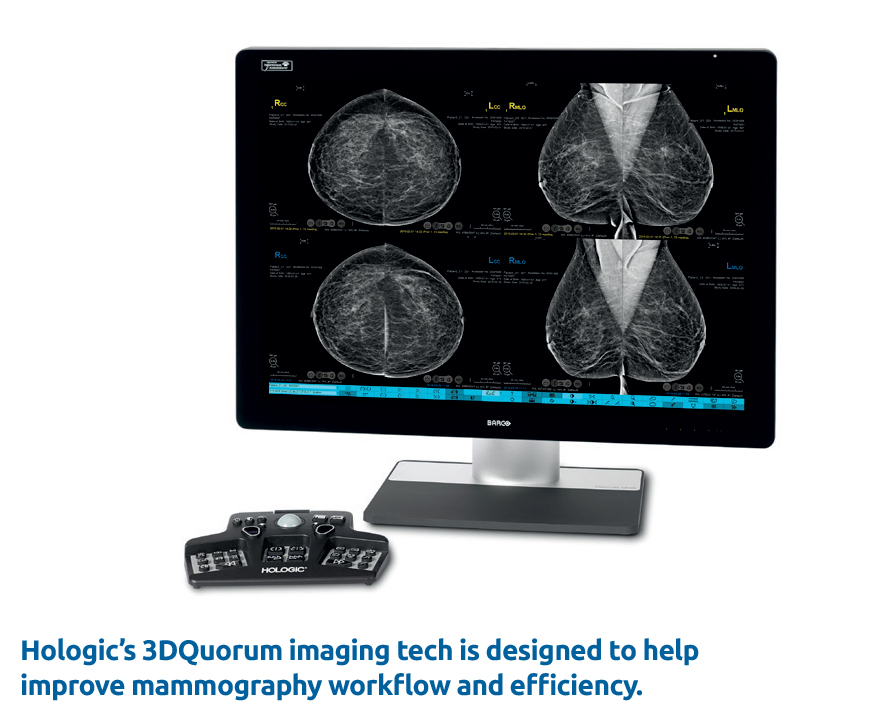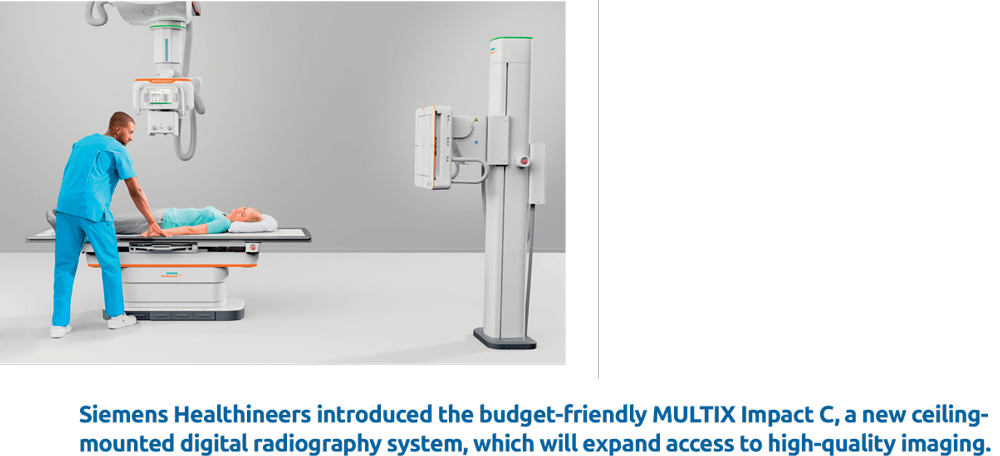RSNA 2020 goes virtual
RSNA 2020 was held virtually from 29 November to 5 December due the Covid-19 pandemic. Since the inception of the RSNA meeting more than a century ago, only twice in history — in 1943 and 1945 due to the war effort — have the organisers been forced to cancel the physical meeting. These are clearly unprecedented times.
Under the theme ‘RSNA 2020: Human Insight/Visionary Medicine’ the organisers say the virtual event provided a successful week of online educational programmes, scientific presentations, educational exhibits and product demonstrations, attracting more than 29,000 registrants from 134 countries.
Along with more than 1,700 research papers and posters and 1,400 education exhibits encompassing the full gamut of radiologic subspecialties and modalities, the meeting tackled important social issues such as global health, diversity and inclusion in radiology, and health disparities and inequities.
The meeting highlighted RSNA’s ongoing commitment to global diversity, equity and inclusion in health care, while showcasing the latest developments in COVID-19 research and artificial intelligence (AI) applications.
COVID-19 dominated the Hot Topic sessions at RSNA 2020 with five sessions covering everything from imaging manifestations of the disease to its impact on workforce resilience. There were 74 sessions on COVID-19.
Popular features like Case of the Day, rapid-fire “Fast 5” presentations, and Image Interpretation sessions provided dynamic experiences for attendees.
As in recent years, AI featured prominently. The AI Showcase and Theatre spotlighted innovative products, solutions and presentations from industry leaders, as well as the “Imaging AI in Practice” demonstration, which outlined different ways AI and machine learning applications could be employed in clinical practice to improve diagnostics and expedite workflow.
Highlights of RSNA 2020
Some of the highlights from the virtual meeting include:
- Giving Tuesday fundraising In 2020, Resoundant committed $25000 to the RSNA Research and Education Foundation to support its Giving Tuesday fundraising efforts. This donation came with a challenge to individuals to join in donating to the Foundation. Donors responded, and the challenge exceeded its goal, helping the Foundation raise more than $25000 in additional donations during RSNA 2020.
- RSNA Chynn Award for Neuroradiology Research Eike Piechowiak, M.D., a neuroradiologist at Bern University Hospital in Bern, Switzerland, was awarded the 2020 Kuo York Chynn Neuroradiology Research Award for his research, “Early Renal Pelvis Opacification on Postmyelography CT as an Indicator for Increased CSF Resorption in Spontaneous Intracranial Hypotension,” which was presented at RSNA 2020.
- Radiology publishes COVID-19 monograph Radiology has published an online monograph on COVID-19, a curated selection of 18 important research, opinion, and guidance articles. A print-on-demand option is available. Visit: https://pubs.rsna.org/page/radiology/covid19 Highlights of RSNA 2020 RSNA 2020 goes virtual
- Special Report provides details on RICORD A Special Report on the RSNA International COVID-19 Open Annotated Radiology Database (RICORD – https://www.rsna.org/covid-19/covid-19-ricord) appears in the January 2021 issue of Radiology. RICORD is the first multi-institutional, multinational expert annotated COVID-19 imaging data set made freely available and designed for the machine learning community. Visit: https://pubs.rsna.org/doi/10.1148/radiol.2021203957
- Radiology publishes International Perspectives on COVID-19 and Value-based Care “RSNA International Trends: A Global Perspective on the COVID-19 Pandemic and Radiology in Late 2020” details experiences and insights from radiology experts in representative countries from around the world. These insights provide a guidepost to help address management challenges as Covid-19 cases continue to rise in many parts of the world and suggest modifications in workflow that are likely to continue after this pandemic subsides. Visit: https://pubs.rsna.org/doi/10.1148/radiol.2020204267
- RSNA President looks to radiology’s future In “My Turn: A New Era for Radiology”, published Jan 2021 in RSNA News, Mary C. Mahoney, M.D., RSNA President, reflects on the challenges faced by radiologists over the past year and stresses the importance of worldwide engagement in 2021. Visit: www.rsna.org/news/2021/january/mahoney-my-turn-new-era
Virtual product launches at RSNA 2020
Several companies provided virtual presentations and demonstrations of new products they are bringing to market. Here we provide a brief overview of new products from a few select companies.
Carestream Health
Carestream Health showcased a number new imaging products across an array of clinical specialties. From bedside imaging solutions to scalable X-ray room systems, the company demonstrated its growing product portfolio that fits budget, workflow, safety and space requirements.
- The DRX-Revolution Mobile X-ray System provides critical bedside imaging and delivers high-quality medical images in tight spaces. Additional features to reduce contamination include flush-mounted displays that provide a smooth surface for easier disinfecting.
- With flexibility and scalability in mind, Carestream’s new DRX-Compass X-ray System offers access to a wide selection of configurable components, tailored to each environment. The system allows mid-tier facilities to expand the types of medical imaging exams they provide, improving patient care and boosting productivity.
- The new DRX-L Detector, which captures long-length, highresolution images for leg length and spine exams with a single exposure, speeds clinician workflow and minimizes patient discomfort. The Focus 35C and 43C detectors are fast, light and an ideal, budget-friendly way for smaller facilities and private practices to upgrade to DR imaging.
- Carestream’s Eclipse is the engine behind the company’s innovative imaging software. It uses artificial intelligence (AI) technology to significantly increase the value of the entire imaging chain, from capture to diagnosis. Eclipse powers features for imaging intelligence, workflow efficiency and healthcare analytics.
- The DRX-Revolution Nano Mobile X-ray System enables Neonatal Intensive Care Units (NICU) to noninvasively and effectively examine and treat children, and conduct chest, intensive care and orthopaedic exams quickly at the patient’s bedside. Portable and nonmotorized, the DRX-Revolution Nano features an ultra-lightweight design for easy manoeuvrability and arm positioning.
For more information, visit: https://www.carestream.com
Philips
Philips showcased an integrated suite of offerings, introducing key solutions to enhance the entire radiology workflow “to address the most pressing operational challenges across diagnostic and interventional radiology”.
One of these solutions is their next generation IntelliSpace Portal 12 – an Advanced Visualization Workspace for radiologists. The IntelliSpace Portal features a robust set of new AI-assisted quantitative assessment and automatic results generation features to support the diagnostic workflow, including follow-up and communication across cardiology, pulmonology, oncology and neurology. Its AI-assisted pulmonary capabilities include the assessment of complex lung conditions associated with COVID-19. Expanding its ecosystem for radiology solutions, new clinical software packages in cardiology, pulmonology, oncology and neurology were launched with IntelliSpace Portal 12. The software also includes a new photorealistic volume rendering technology using an interactive virtual light source to improve the visualization of volumes in terms of their depth and relationship to other key anatomies – enhancing its use as an educational and communication tool.
Other enhancements in IntelliSpace Portal include workflow innovations for vascular analysis to deliver faster results, new automatic lesion segmentation propagation between timepoints for longitudinal tumour tracking, new Caas myocardial strain quantification software, and enhanced automatic capabilities for CT coronary analysis.
Philips noted that as the COVID-19 pandemic continues to highlight how interconnected the world’s social, economic and environmental challenges are, the company remains fully focused on delivering against its triple duty of care: meeting critical customer needs, safeguarding the health and safety of its employees, and ensuring business continuity. “As a purpose-driven health technology company, Philips is applying its innovation strength to improve the health and well-being of people. The company is deeply committed to doing business responsibly and sustainably, recently setting out a range of challenging new environmental, social and governance targets.”
For more information, visit: https://www.usa.philips.com/healthcare/product/HC881101/intellispace-portal-12
Hologic
Hologic showcased its portfolio of breast and skeletal health products, including screening, surgical, interventional and ultrasound solutions. Two of their newest products include:
- 3DQuorum The 3DQuorum imaging tech is designed to help improve mammography workflow and efficiency, which is critical as clinics strive to manage the backlog of women whose routine breast screening was delayed due to the Covid-19 lockdown. The 3DQuorum technology uses Genius AI-powered analytics to reconstruct high-resolution 3D data to produce 6mm “SmartSlices”. These analytics identify clinically relevant regions of interest and preserve important features during reconstruction of the SmartSlices. SmartSlices expedite read time by reducing the number of images for radiologists to review, without compromising image quality, sensitivity or accuracy. With 3DQuorum technology, the number of 3D images to review is reduced by two-thirds, saving an average of one hour per eight hours of daily image interpretation time.
For more information, visit: https://www.hologic.com/hologicproducts/breast-skeletal/3dquorum-imaging-technology
- Faxitron Path+ This new versatile specimen radiography system features a larger field of view and optimized imaging capabilities, helping it deliver greater efficiency for pathologists and more timely results for patients. The Faxitron Path+ system features a high-resolution imaging detector which enables pathologists to image a wide range of specimens of varying sizes, including bone, foetal remains and breast tissue directly in the lab. By combining a larger field of view with intuitive, easy-to-use software, the system provides pathologists with accurate, efficient results. Additionally, the clear specimen images produced enable pathologists to satisfy the regulatory demands for De-Calcification End Point testing. The Faxitron Path+ system provides up to 10x geometric magnification, enabling imaging of small microcalcifications and ensuring accurate diagnoses. Optimal X-ray exposure settings can be selected regardless of specimen makeup and density to ensure the highest image quality is maintained. These features offer pathologists more versatile imaging options and help to reduce the turn-around time for reports.
For more information, visit: https://www.hologic.com/hologic-products/breast-skeletal/faxitron-path-plus-specimen-radiography-system-0
Agfa HealthCare
Agfa HealthCare launched RUBEE for AI, which enables hospitals to embed best-in-class Artificial Intelligence to their Enterprise Imaging ecosystem. RUBEE forms the core of the Enterprise Imaging platform. With the RUBEE for AI, specialty packages are seamlessly embedded into radiology workflows. RUBEE helps visualise the metadata generated by the AI algorithms, and then uses that information to automate and optimize clinical workflows. This improves productivity and enhances informed decision making.
The market for healthcare-based AI algorithms has boomed, leaving hospitals faced with an increasing number of individual applications to choose from. Agfa Healthcare says “RUBEE for AI takes away the time-consuming guesswork of choosing and implementing each algorithm, with specialty AI packages that address specific clinical needs.”
The AI applications have been carefully selected to verify they come from reliable solution providers, use the right datasets, follow industry standards, and are integrated seamlessly. Hospitals may also decide to use RUBEE for AI to embed their own choice of AI applications, including for research and academic use leveraging the Enterprise Imaging academic teaching and peer learning workflows.
Breast and CT Lung AI packages Agfa Healthcare also demonstrated their Breast AI package and CT Lung package. The Breast AI package for breast imaging is powered by RUBEE – and Transpara, which is the first FDA-cleared and CE-marked AI solution based on deep learning for both 2D and 3D mammography.
Transpara uses a deep learning algorithm to automatically score mammograms based on their risk of indicating cancer. CAD and AI based region analysis offer key decision support tools.
Combining Transpara capabilities with RUBEE for AI enables advanced visualizations, workflow automation and triage, as well as an Enterprise Imaging strategy by reducing the IT complexity and improving interoperability. With automated task prioritization, smart display of findings, dedicated reading protocols and automated reporting, reading is faster, early detection is improved, and patient satisfaction is enhanced.
The CT Lung package is powered by RUBEE and ClearRead CT. ClearRead CT is the first FDA-cleared system for concurrent reading, for all nodule types, with a demonstrated capability to improve efficiency (26% reduction in reading time) and accuracy (29% reduction in missed actionable nodules). ClearRead CT brings advanced tools that include vessel suppression, nodule detection and comparison.
RUBEE helps improve a radiologist’s workflow with automated sorting and prioritization of studies, smart display of AI generated findings, dedicated reading protocols, and automated reporting. Automated comparison of prior and current images can help identify new lesions and measure changes for timely follow-up.
For more information, visit: https://global.agfahealthcare.com/augmentedintelligence/rubee-for-ai-image/
Siemens Healthineers
Siemens Healthineers held a virtual experience called SHAPE 21. As well as several new product launches the company issued a positioning statement, saying: “We believe that delivering high value care rests on four essential strategies: expanding precision medicine; transforming care delivery; improving patient experience; and digitalizing healthcare.
“A particular focus this year is on access to care, and digitalization. We believe these are two of the more pressing issues facing providers worldwide – and we are confident that the breakthroughs we introduce to the Radiology community will play an important role in addressing these challenges in the years ahead.
LUMINOS Lotus Max
The company introduced the LUMINOS Lotus Max, a premium 2-in-1 remote-controlled imaging system that seamlessly integrates fluoroscopy and radiography for increased productivity and optimized clinical operations. In this manner, the LUMINOS Lotus Max transforms the delivery of patient care.
Designed to be operated remotely from a control room, the LUMINOS Lotus Max also can be used tableside via an optional second remote control console. Either way, the LUMINOS Lotus Max offers a high degree of versatility in a wide range of clinical examinations and among diverse patient types. It combines radiographic and fluoroscopic imaging with orthopedic studies such as long-leg or full-spine examinations and basic interventions. Because these radiographic and fluoroscopic capabilities are highly integrated, users can quickly switch between the two forms of imaging. The LUMINOS Lotus Max also features a high level of automation for easy manoeuvring at the touch of a button.
For more information, visit: https://www.siemens-healthineers.com/fluoroscopy/over-table-systems/luminos-lotus-max
MULTIX Impact C
At the virtual RSNA Siemens also debuted the MULTIX Impact C, a new ceiling-mounted digital radiography (DR) system, and launched the MULTIX Impact VA20, a new version of the established floor-mounted parent DR system. Both systems are affordably priced to expand access to high-quality imaging and enhance the patient experience.
The MULTIX Impact C and the MULTIX Impact VA20 each possess an intuitive operating system, versatile wireless detectors, motorized tube heads, and a free-floating, flat tabletop, which enables easy patient access. The touch user interface on the X-ray tube permits the radiologic technologist to remain by the patient’s side for longer periods of time. And when in the control room, the technologist can use the patient positioning camera to continuously monitor the patient.
A key feature of the MULTIX Impact C and the MULTIX Impact VA20 is MyExam Companion – the user interface that provides proactive guidance to help technologists navigate a radiography procedure regardless of skill level. MyExam Companion combines available patient data such as gender and age with other user or machine-observable, patientspecific information to identify optimal acquisition and reconstruction parameters for each patient and radiography procedure.
For more information, visit: https://www.siemens-healthineers.com/en-au/medical-imaging/radiography/digital-x-ray/multix-impact-c





